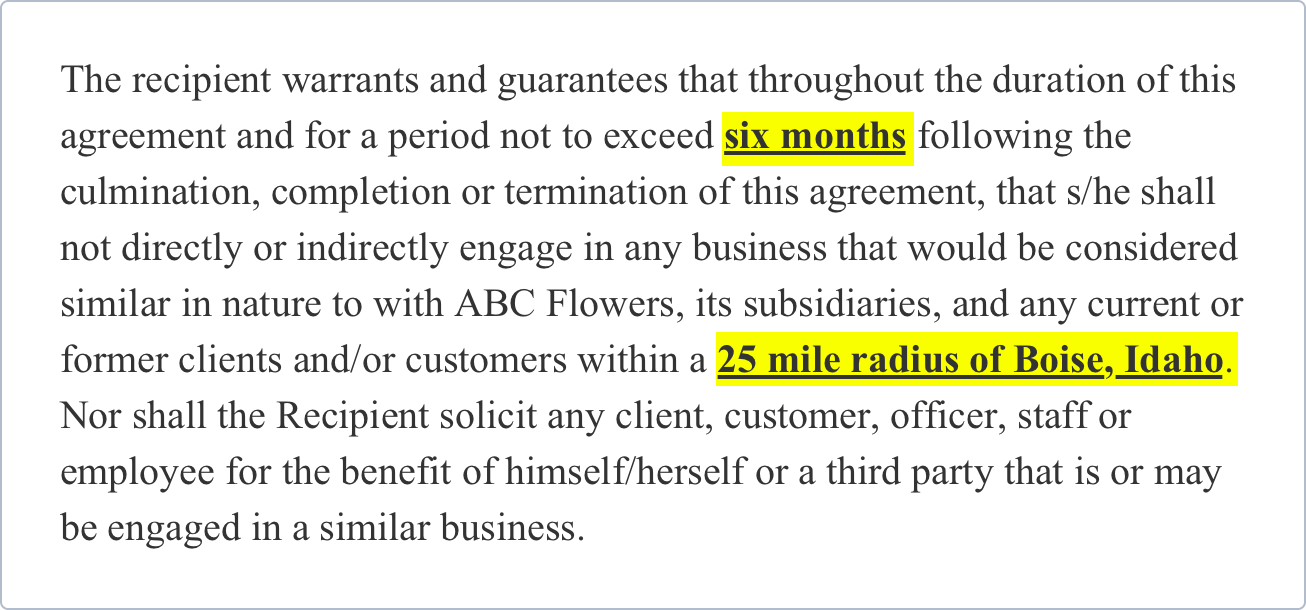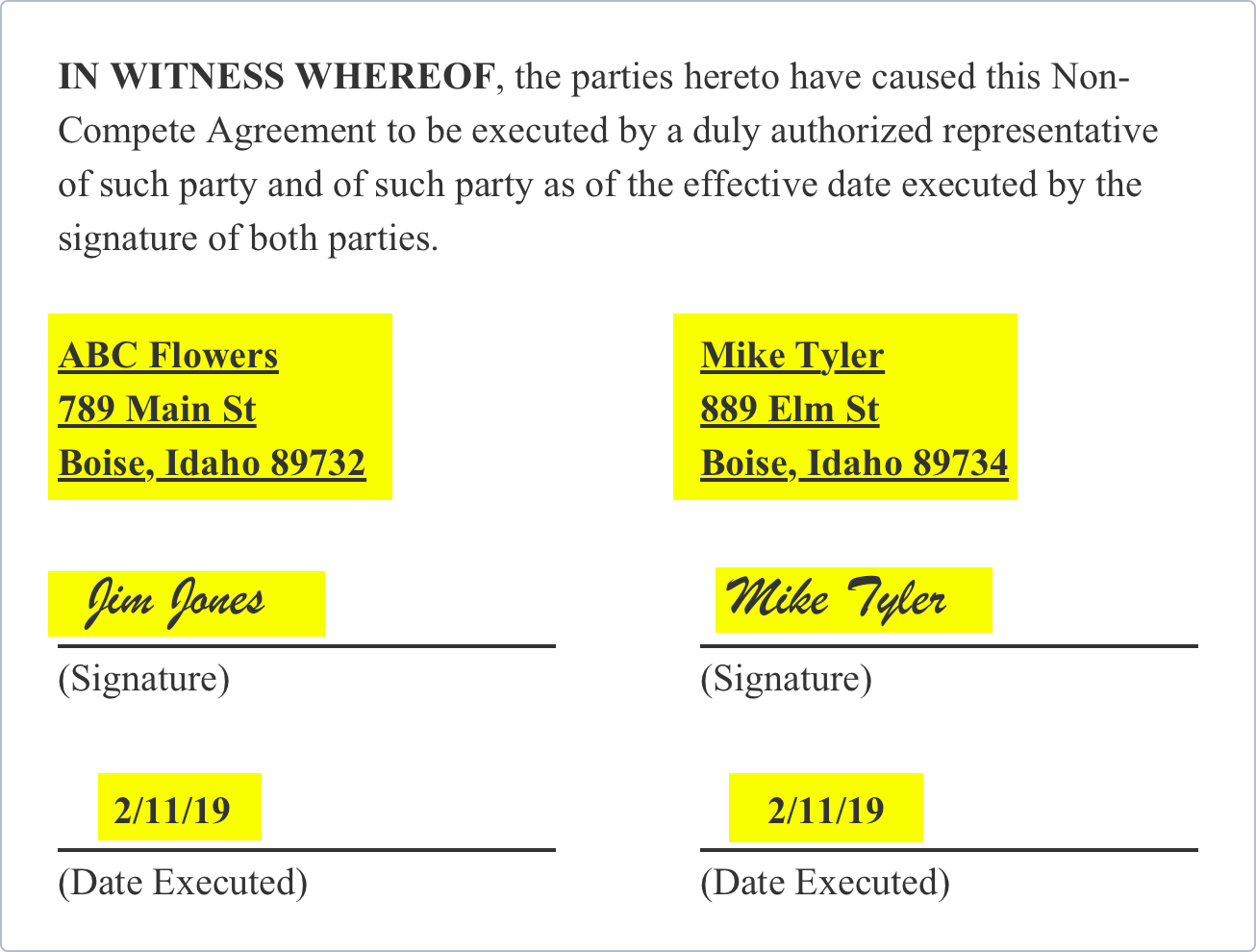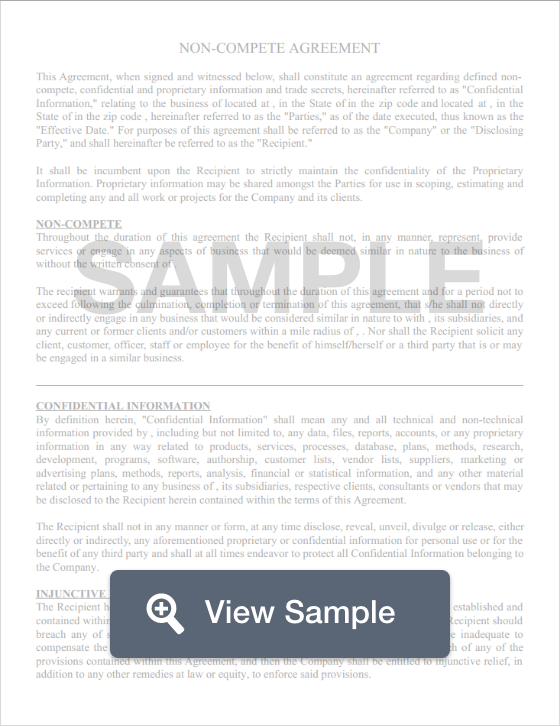What is a Non-Compete Agreement?
A non-compete agreement (NCA) (or a non-compete clause) prevents another party from starting or working for a similar business or new employer that could compete with yours or threaten its market share. In some cases, restrictive covenants may only apply to a certain geographic radius or region (referred to as geographic scope) and may only last a certain amount of time. These documents may be referred to as non-competition agreements or non-compete contracts and are often used along with a nondisclosure agreement.
Recent data suggests that around 20% of the United States workforce are bound by non-competes, including 14% of those earning less than $40,000 per year.
Download a blank, printable non compete agreement template at the top or bottom of this page.
Creating a State Specific Non-Compete
A non-compete agreement is an important document business can use with both employees and contractors to protect their competitive edge. The purpose of the document is to take away the employee’s or contractor’s ability to perform a certain type of work for themselves or a competitor within a certain geographical location.
Non-compete agreements also include a period that limits what the employee or contractor cannot do. Non-competes must comply with the laws in the state where the business is located. Here are the six steps used to create a non-compete.
Step 1: Learn the State Laws
Non-compete agreements are governed by trade secret laws in the state where the business is located. Before writing one, it’s important to read the laws so that you know what is legal and what is not legal. Some states do not recognize these agreements. Most states provide a specific amount of time as well as define the geographical location that may be used by the employer.
Writing a document that is outside the scope of the laws in your state could mean that the document is not enforceable even if the document includes a severability clause to protect the parts that comply.

Step 2: Do Your Research to Decide What Limits to Set
Most states will not uphold overly broad non-compete agreements. You must do your research on competitors to determine whether you should include working for them in the agreement. However, if you’re contracting or hiring someone who is considered a remote worker, there may be some limitations on whether you can prohibit them from doing certain types of work.

Step 3: Choose the Right Geographical Limit
As stated earlier, the geographical limit you choose is likely regulated by the trade secret laws in your state. Also, be reasonable. If your business is located in Texas and it only does business in the midwest, it might not be seen by the court as reasonable if you attempt to stop the employee or contractor from doing the same or similar work in California, Washington, or Florida.

Step 4: Choose the Amount of Time the Agreement Will Be in Effect
Review the trade secret law in your state so that you don’t set an excessive time limit for the agreement. Many states have a limit of one or two years that a non-compete may be in effect.

Step 5: Include a Clause for No Solicitation
In a non-compete agreement, a no-solicitation clause is used to prevent employees and contractors from trying to entice your other employees or contractors and your clients from working for or with them for the duration of the agreement.

Step 6: Executing the Non-Compete Agreement
The agreement should be signed and dated by the employee or the contractor. In most states, there is no requirement to have a notary witness the signature. However, involving a notary can help prove the authenticity of the document.

Non-Compete Agreements FAQs
These questions cover everything you need to know about non-compete agreements (NCAs) or clauses. We explain what they are when you need one as an employer, the legal guidelines for NCAs, whether an employee or contractor should sign one, the pros and cons of NCAs on the economy as a whole, and more. After reading this guide, you’ll have all the knowledge to confidently move forward.
What is a CNC?
CNCs typically refer to three different types of NCAs. Those are:
-
Traditional non-compete: An employee cannot work for a direct competitor within a specific geographic area identified in the agreement for a set time and/or in a particular division.
-
Non-solicitation agreements: Prohibits employees from contacting the customers, employees, or suppliers of the former employer.
-
Confidentiality agreements or non-disclosures: Prohibits employees from utilizing and divulging sensitive information, intellectual property, and client lists of their former employer.
What to keep in mind
Before you expose an employee or contractor to the intricate workings of your business, it’s a good idea to have them sign an NCA or to include one in the work contract. It's much easier to do this before the employment relationship begins because they do not apply to past actions or exposure to information; they take effect on the present date or future date and continue for a specific amount of time into the future. For maximum protection, you should make executing this document a priority.
-
Don’t Be Shy About Using Templates
-
There are plenty of reputable websites that offer simple non-compete agreements that you can download and fill out. This method simplifies several steps for you because the organization and formalization of the document are already taken care of. All you need to do is prepare and enter the information required by the template before the employee signs.
-
-
Include All Details
-
Vague language doesn’t protect anything. Unless you outline the details of what your employee or contractor needs to do or not do, your non-compete agreement or clause is useless. Be sure to provide details on limitations, such as the duration of the agreement, identifying direct competition, and the geographical area to which it applies (you can’t say the agreement is for the entire world, forever).
-
-
Compensation
-
Compensation is usually called “consideration” in the agreement. This is whatever you pay your employee or contractor to adhere to the agreement. In the case of a new employee, the compensation could be a job offer. In others, it can mean money. Be sure that you evaluate how much your captive market is worth to you and structure your agreement accordingly.
-
Who Needs a Full Non-Compete or Clause?
Here’s a simple question to help you determine whether a business should offer a full non-compete or clause:
Will the employee or contractor have access to proprietary information?
If so, it's advisable to consider completing a non-compete. If not, non-competes may not be necessary. To know for sure, you can always consult with a lawyer who specializes in business.
If you own a business in Texas, you should know that most NCAs (also referred to as a covenant not to compete) is illegal. Utah restricts the time limit to one year. North Dakota enforces them only in very limited circumstances. California law states that NCAs are void.
What are the Components of a Non-Compete Agreement?
If you’re starting a business in food, apps, publishing, or any other competitive industry, it is particularly important to have a non-compete agreement or clause in place. Non-compete agreements, enforceable against employees and contractors in most states, may protect your business from people who cheat.
By that, we mean employees or contractors who leave your company and immediately start a competitive business of their own using your hard-won trade secrets. A non-compete clause protects your business, but it’s not a stand-alone agreement. It is a single clause that is placed inside of a service or employment contract.
The main components of a stand-alone NCA include:
The Naming of Parties Involved
This is pretty straightforward. Include the full legal name and address of your business entity (the “Protected Party”) and the full legal name and address of the employee signing the agreement (the “Non-Competing Party”). In a non-compete clause, you’ll likely just reference the parties by name as through the rest of the contract the clause is placed within.
Duration and Geographic Range of Agreement
Most non-compete agreements have limited lifespans. The lifespan is based on local law. You’ll also need to list the date that the document becomes effective. You must also specify the area across which the agreement applies, such as “the State of Oregon” or “within 40 miles of Boston city limits.” The restrictions are only enforceable if they are reasonable in the eyes of the law.
Details of the NCA
This is a sticky subject, legally speaking. If you get stuck, you should speak with an employment lawyer for help. Since most courts rule in favor of an employee’s or contractor’s right to make a living, you can only really protect legitimate business secrets. Something else to keep in mind is that the court will not enforce something it considers to be against public policy, either.
Compensation
For the agreement to be legally enforceable, the non-competing party must receive compensation. If the party is a new employee or contractor, the job itself is usually enough. However, if it’s an existing employee or contractor, compensation may take the form of a promotion, pay raise, or one-time cash payment or installments. Installments may be paid in any interval you choose, whether it is by the hour, by the month, or by the year.
Consequences
You must explain the consequences of violating the agreement. If you're not sure about the legalities, talk with an employment attorney. It details what the employer is entitled to receive should the other party break the rules of the non-compete agreements or clause. Often, these will take the form of a financial settlement or undesirable legal consequences.
Signatures
Like any legal document, a non-compete agreement is not legal without the signatures of all involved parties.
Pros and Cons of NCA's
Pros:
-
For employers, NCAs help promotes long-term relationships with their employees and contractors, enabling employers to spend more money on training and skill development.
Cons:
-
NCAs limit worker flexibility and can force employees to relocate their entire life simply to pursue a new employment opportunity instead of staying with their old company.
-
NCAs restrict market competition and inhibit the free market.
-
NCAs reduce innovation.
-
According to a recent study from UCLA, NCAs reduce workers’ mobility and force them to stay in jobs where they make less money.
-
This study also suggests that firms invest more in research and development when their investment is protected by non-competes but also shows that workers bound by NCAs pursue less training thereby reducing the overall investment in human capital.
-
-
Restricts competition.
-
Virtually every study on NCAs finds they reduce wages since many workers get their largest raises when they pursue jobs at other companies.
-
Noncompetes also tend to prevent growing businesses from hiring as quickly as they would like which can harm the overall economy by keeping talented workers from joining new companies.
-
Legal Considerations of an NCA
-
They must be supported by consideration at the time of signature.
-
They must protect a legitimate business interest of the employer.
-
For example, an employer may use a non-compete to protect certain information and/or prevent a former employee or contractor from competing with them in the same or an extremely similar industry. Employers must show, in general, that it took reasonable measures to keep that information secret, and that said information affords the employer a competitive advantage.
-
-
They must be reasonable in scope, geographic boundary, and length of time.
-
Courts balance the employer’s business interests with the burden on the person signing the agreement. Any non-compete deemed too burdensome (too long, overly broad in scope and length of time) will likely not hold up in court. So, when writing a non-compete to protect your business’ confidential information, the duration of the agreement shouldn't be any longer than the time for which the information will have value. This is generally governed by local law.
Enforcing Non-Competes
State law dictates the enforceability of non-compete agreements and clauses. Often, non-competes are unreasonable and can harm employees and contractors for more than they protect businesses. You must familiarize yourself with your state’s non-compete laws. Without a good understanding of them, you may be unable to enforce the terms.
State Restrictions on Non-Compete Agreements
Non-competes can severely inhibit a worker’s ability to earn a living. Because of this, states have legislation that limits the scope of non-competes. However, the degree to which states limit the scope of non-competes varies widely. We mentioned the specific state restrictions earlier in this guide.
Given the wide range of state variation on these matters, we recommend you consult an attorney regarding your state’s laws before creating, or signing, a non-compete.
Tips for Negotiating
Any worker in a creative field is likely to come across an NCA at some point in their career. Consider these tips during negotiating:
-
Ask for clarification: Read your employment agreement carefully, especially any section related to non- compete. If you find any language confusing, ask for clarification. Once you have a solid grasp of what your contract entails, negotiate the limitations of these provisions before signing it.
-
Make sure you’re legally protected: If you’re considering a new job with an NCA and you have one with an old job, look over the new contract to see if the new company offers legal protection in the event of a lawsuit by the previous company.
-
Consider state laws regarding geography: In states where NCA is not enforceable (e.g. California), workers can work for one startup company and move to another without any geographic limitations or penalties. In other states, like New York and Massachusetts, this is not the case.
-
Make sure the non-compete scope is specific: Clarify any vague language regarding the scope of the non-compete. For example, if the NCA prohibits you from working with a “competitor” but does not provide a specific list, be sure to clarify what, exactly, denotes a competitor and which companies meet the definition. If you don’t, what you consider a “related” company may be a “competitor” in your employer’s view.
-
Limit the duration of a non-compete: This is especially true if you work in a rapidly developing industry like technology. In industries like these, long-term non-compete can significantly inhibit your ability to find better positions or work at all.
A Sample Non-Compete Agreement with Examples for Each Step
Step 1: Company Information
In this first portion of the Non-Compete Agreement, provide the company information that the individual is agreeing not to compete with. This should include the following information:
-
Company Name
-
Company Address (including city, state, and zip code)
Besides, include the individual's name and information who will refrain from competition with the company. This should include:
-
Individual's Full Name
-
Individual’s Home Address (including city, state, and zip code)

Step 2 - Limitations:
Specify the limitations that the individual must adhere to once his or her relationship with the company ends. This information should be a specific amount of time and geographic radius. It is important to remember that these limitations must be fair in both time and geographic radius to prevent causing unnecessary hardship on the individual. Include the following information:
-
Length of time individual is restricted from engaging in competitive behavior
-
Geographic radius individual is restricted from working for a competing company or engaging in competitive behavior.

Step 3 - Governing Law:
Laws concerning Non-Compete Agreements vary from state to state and sometimes from county to county. In this step, declare the county and state where the agreement will be effective.

Step 4 - Signatures:
List the names and addresses of both parties. This includes:
-
Company Name
-
Company Address (including city, state and zip code)
-
Individual's Full Name
-
Individual’s Address (including city, state and zip code)
Ensure both parties sign and date the agreement.

Legal Forms Related to a Non-Compete Agreement
-
Cease and Desist Letter: A cease and desist letter is a formal notice to a party to immediately stop an act that is seen as a violation of another party’s intellectual or physical property rights.
-
End-User License Agreement: An end-user license agreement defines user rights for a party concerning a piece of software being utilized.
-
Non-Disclosure Agreement: A non-disclosure agreement is a form that establishes information two parties have agreed to not divulge, often during a business relationship.
-
Waiver Agreement: A waiver form releases a company or individual from liability for an act knowingly agreed upon and participated in by the signer of the waiver release.
Download a PDF or Word Template
Non-Compete Agreement
A Non-Compete Agreement is essential for businesses entering into collaborative arrangements with external business colleagues, freelancers and contractors. It legally obliges specified parties not to undertake actions that amount to competition for a given period.
 Read More
Read More
Non-Disclosure Agreement
A Non-Disclosure Agreement is a document which protects business interests in the event of entering into new business relationships with fresh employees, business partnerships, JV's, sub-contracting or similar. It obliges the business partner to maintain confidentiality about specific areas of business.
 Read More
Read More
Employee Handbook
An Employee Handbook is used by companies to outline specifically what is expected of all employees. It can be generic, or may be category specific. It is also used as a supplement to training.
 Read More
Read More
Employment Contract
An Employment Contract sets out the terms and conditions of a job. It establishes rights and responsibilities of employee and employer, including salary, working hours, notice term, etc.
 Read More
Read More

